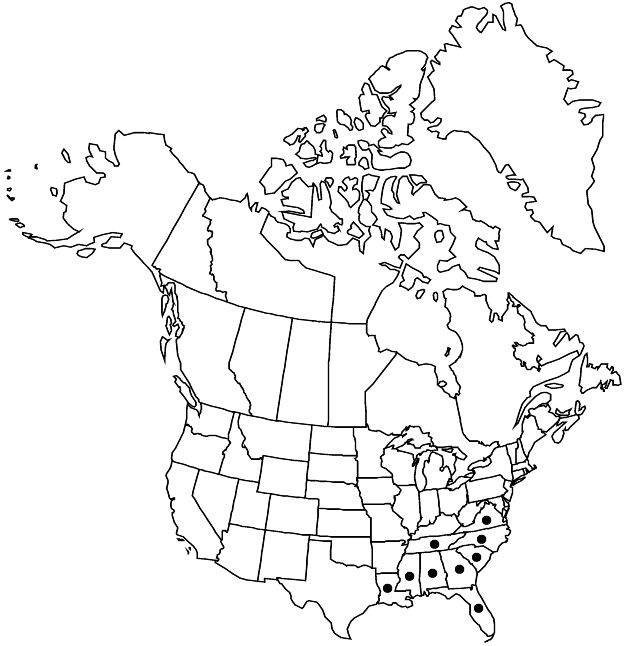Difference between revisions of "Hypericum nudiflorum"
Sp. Pl. 3: 1456. 1802.
FNA>Volume Importer |
FNA>Volume Importer |
||
| Line 15: | Line 15: | ||
|name=Brathydium nudiflorum | |name=Brathydium nudiflorum | ||
|authority=(Michaux ex Willdenow) K. Koch | |authority=(Michaux ex Willdenow) K. Koch | ||
| − | }}{{Treatment/ID/Synonym | + | }} {{Treatment/ID/Synonym |
|name=Myriandra nudiflora | |name=Myriandra nudiflora | ||
|authority=(Michaux ex Willdenow) Spach | |authority=(Michaux ex Willdenow) Spach | ||
| Line 33: | Line 33: | ||
|elevation=0–1000 m | |elevation=0–1000 m | ||
|distribution=Ala.;Fla.;Ga.;La.;Miss.;N.C.;S.C.;Tenn.;Va. | |distribution=Ala.;Fla.;Ga.;La.;Miss.;N.C.;S.C.;Tenn.;Va. | ||
| − | |discussion=<p>See under 15. Hypericum apocynifolium for differences between it and H. nudiflorum, which has a more eastern distribution. Records from Texas probably are referable to H. apocynifolium.</p><!-- | + | |discussion=<p>See under 15. <i>Hypericum apocynifolium</i> for differences between it and <i>H. nudiflorum</i>, which has a more eastern distribution. Records from Texas probably are referable to <i>H. apocynifolium</i>.</p><!-- |
| − | --><p>Hypericum nudiflorum probably is now extirpated in Louisiana.</p> | + | --><p><i>Hypericum nudiflorum</i> probably is now extirpated in Louisiana.</p> |
|tables= | |tables= | ||
|references= | |references= | ||
| Line 58: | Line 58: | ||
|publication year=1802 | |publication year=1802 | ||
|special status=Endemic | |special status=Endemic | ||
| − | |source xml=https://jpend@bitbucket.org/aafc-mbb/fna-data-curation.git/src/ | + | |source xml=https://jpend@bitbucket.org/aafc-mbb/fna-data-curation.git/src/8f726806613d60c220dc4493de13607dd3150896/coarse_grained_fna_xml/V6/V6_132.xml |
|genus=Hypericum | |genus=Hypericum | ||
|section=Hypericum sect. Myriandra | |section=Hypericum sect. Myriandra | ||
Revision as of 17:45, 18 September 2019
Subshrubs, erect, usually loosely branched with branches ascending, 5–20 dm. Stems: internodes narrowly 4-winged at first, then terete. Leaf blades ovate-lanceolate or elliptic to linear-oblong, 30–70 × 7–25 mm, base not articulated, cuneate to subcordate, margins plane, apex obtuse to rounded, midrib with to 6 pairs of branches. Inflorescences corymbiform to rounded-pyramidal, 7–45-flowered, narrowly branched, sometimes with 1–7(–40)-flowered dichasia from 1–3 proximal nodes. Flowers 15–20 mm diam.; sepals deciduous, not enclosing capsule, 5, oblanceolate-spatulate to narrowly triangular, unequal to subequal, 2–5 × 1–1.5 mm; petals 5, pale or coppery yellow, oblanceolate-oblong to elliptic-oblong, 6–8(–10) × 3–4 mm, length 2–3 times sepals; stamens persistent, 80; ovary 3(–4)-merous, placentation incompletely axile. Capsules broadly ellipsoid to ovoid-globose, 3.5–7 × 3–5 mm. Seeds markedly carinate, 1.5–2 mm; testa ± scalariform-reticulate. 2n = 18.
Phenology: Flowering summer (Jun–late Aug).
Habitat: Stream banks, moist woodland, swamps
Elevation: 0–1000 m
Distribution

Ala., Fla., Ga., La., Miss., N.C., S.C., Tenn., Va.
Discussion
See under 15. Hypericum apocynifolium for differences between it and H. nudiflorum, which has a more eastern distribution. Records from Texas probably are referable to H. apocynifolium.
Hypericum nudiflorum probably is now extirpated in Louisiana.
Selected References
None.